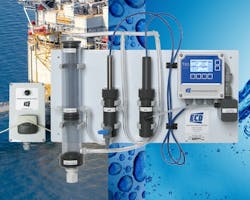An international oil and gas company that operates a liquid natural gas (LNG) terminal on Italy’s Adriatic Sea coast recently encountered a problem with its wastewater treatment process. Before the water is released back into the Adriatic Sea after its use at the terminal’s operations, it must be treated to ensure it is safe and will not harm or pollute the environment.
Coastal LNG terminals and processing facilities require a significant amount of water for use in their operations. The water is typically drawn from rivers or the sea and is used as:
- Heat exchanger cooling water for liquefaction processes (gas to liquid state);
- Gas re-vaporization water heating systems (liquid to gas state);
- Storage tank bottom wastewater resulting from condensation;
- Vessel ballast water that must be periodically discharged;
- Employee housing, cooking and sanitation;
- Storm water runoff; and
- Fire system water supplies.
The wastewater treatment process requires disinfection with chlorine to eliminate any disease-causing pathogens that might harm aquatic life. After the water has been disinfected, any residual chlorine must be removed prior to releasing the effluent. A dechlorination process analyzer samples the treated water to make sure it is safe for discharge prior to final release.
The Problem
The LNG terminal operator was experiencing data accuracy problems and high maintenance costs with its existing conventional dechlorination analyzer. Inconsistent chlorine level readings were requiring additional treatment cycles, which the plant’s technicians suspected were unnecessary and caused by a faulty analyzer.
Under the best of circumstances, disinfecting treated water is a challenge. Chlorine remains the most popular disinfection method, though there are other options. Care must be taken to ensure discharged effluent is not overly chlorinated.
At the LNG terminal’s wastewater treatment operation, chlorine is added to the water in a chlorine contact chamber prior to the final outfall of the plant. The free chlorine residual level needs to be kept high enough in the contact chamber to kill any disease-causing bacteria and viruses. High chlorine levels, however, can be toxic to aquatic life in both fresh- and saltwater environments.
Additional treatment must be performed to reduce chlorine levels prior to discharge from the plant. Once dechlorinated, the water leaving the treatment plant can be reused safely (for landscaping and irrigation) or released back into the environment (oceans, rivers, streams and lakes).
In order to assure that the dechlorination process is effective and to stay within government set discharge limits, the water leaving the plant needs to be monitored for total chlorine. Total chlorine is made up of the sum of free chlorine and combined chlorine left in the water.
The Solution
Measuring total chlorine in low-chlorine applications such as wastewater treatment final effluent is a difficult and maintenance-intensive application. The operations team at the LNG terminal contacted the applications group at Electro-Chemical Devices Inc. (ECD) in Anaheim, Calif., through its manufacturer’s representative and a system integrator responsible for Italy for discussions about its water effluent problem.
After thoroughly reviewing the issues and then discussing alternative options, the ECD applications team recommended the use of amperometric chlorine sensors. They are a low maintenance and cost effective technology designed to accurately measure both free chlorine (in the contact chamber) and total chlorine (in the final effluent).
Chlorine sensors designed with amperometric technology offer a number of potential benefits for the continuous measurement of both free and total chlorine. At the LNG terminal’s wastewater treatment plant, the chlorine discharge limit must meet stringent regulatory requirements for total chlorine levels that are very low when the water is being introduced back into an environmental body of water.
ECD told the LNG terminal operator that amperometric sensors are economical to use and require low maintenance, but they have two potential issues when used in a low- or no-chlorine environments.
- If the discharge limit is close to or lower than the minimum detection limit of the system being used for the measurement (amperometric chlorine sensors’ minimum detection limit is 0.05 ppm), this becomes a difficult measurement to make reliably over and over.
- Amperometric total chlorine sensors are unstable and require additional maintenance when measuring in near-zero chlorine environments. The ECD team, however, presented the LNG terminal operations team with a “best of both worlds” solution that would resolve these common issues with amperometric sensors.
ECD’s Model DC80 dechlorination analyzer uses a low-cost, low-maintenance amperometric total chlorine sensor and solves both of the issues discussed with the LNG terminal operator. ECD has solved those two issues with its Model DC80 analyzer through zero-offset programming and by adding a chlorine-dosing pump.
The zero-offset programming allows an accurate and reliable measurement without the need for excessive maintenance. The DC80 analyzer system incorporates a chlorine-dosing pump that injects a specific known amount of chlorine into the system before the chlorine measurement is made.
The zero-offset programming allows the user to set an offset in ECD’s T80 transmitter that shifts the zero point by the amount of chlorine being added to the system. The chlorine sensor is now in a sample that contains chlorine, so the total chlorine sensor will provide a stable and reliable measurement with little maintenance required to the system.
If the chlorine concentration in the process increases, the user will see the value on the display increase in the ppm reading. If the reducing agent used to remove the chlorine (typically sulfite or bisulfite) increases, the chlorine reading on the display will go negative.
This approach allows the wastewater treatment plant to accurately read zero or close to zero chlorine in the discharge line with a cost-effective, low-maintenance amperometric chlorine sensor. It also gives the extra benefit of informing the user if the reducing agent is being overfed, thus saving money on chemicals.
The Model DC80 is a ready-to-use plug-and-play dechlorination analyzer. It is designed with a pH-compensated amperometric total chlorine sensor with zero-offset programming to perform the total chlorine measurement. The total chlorine sensor’s range is 0.05 to 20 ppm with the chlorine range zero-shifted from 0 to 20 ppm. The system will read negative ppm if excess reducing agent is present.
Conclusions
The LNG terminal operator installed the new ECD DC80 dechlorination analyzer system as recommended. With the analyzer’s plug-and-play design, the setup and commissioning were quickly completed without any special tools or technician training.
The analyzer has been operating for over one year without incident, and it confirmed the LNG terminal operating team’s suspicion that the previous analyzer was delivering inaccurate readings. Since the installation of the new DC80 analyzer, the company has installed the product at several other refineries and terminals.



